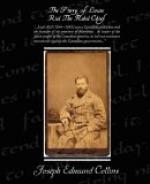On the re-opening of the Court, counsel expressed themselves ready to proceed. Only a few minutes were taken up in selecting a jury. Twelve persons were called, five of whom were peremptorily challenged by the defence, and one by the Crown. The remaining six were sworn in to try the prisoner at the bar. Their names are as follows: —H. J. Painter, E. Everett, E. J. Brooks, J. W. Merryfield, H. Dean, and F. Crosgrove. During the selection of the jury, it is observed by a correspondent of The Mail, to whom we shall be indebted for the reports of the trial, in making the present abstract, “that Riel anxiously watched the face of every man as he was selected and sworn, as though he could read their inmost thoughts as they took the oath.”
After reading the indictment to the jury, Mr. B. B. Osler, Q.C., opened the case for the Crown, in which he explained the nature of the charge against the prisoner, whose career he traced through the successive steps of the rebellion, and indicated the weight and character of the evidence to be brought against its wicked instigator and chief leader. The plea of the defence of the incompetence of the Court to try the case, was first answered by the learned counsel, who remarked, that the character, and composition of the Court, as well as the provision for the trial of capital offences by a jury of six men instead of twelve, were in harmony with the Dominion Law enacted for the Government of the Territories, and that the Dominion Parliament had the right, under the British North America Act, to make that law. “The absence of the Grand Jury was explained, on the ground that such juries were essentially county organizations, and were impossible in large districts with small and scattered populations.” The same reason explained the limiting of the jury to half the usual number. It was also stated that the Crown deemed it unwise, if indeed it were not impossible, to issue a Special Commission for the trial of the prisoner.
Mr. Osler proceeding said, that Riel not only aided and abetted the illegal acts of the rebels, but directed these acts.
“The testimony he claimed,” says a writer in The Illustrated War News, “was abundantly sufficient to bring home to the prisoner his guilt in the charges against him. He (Mr. Osler) read the document in Riel’s handwriting to Crozier, in which Riel threatened a war of extermination against the whites, and traced the prisoner’s conduct afterwards to show that he had tried to carry out that threat. It was no constructive treason that was sought to be proved, but treason involving the shedding of brave men’s blood. The accused had been led on, not by the desire to aid his friends in a lawful agitation for redress of a grievance, but by his inordinate vanity and desire for power and wealth.”




